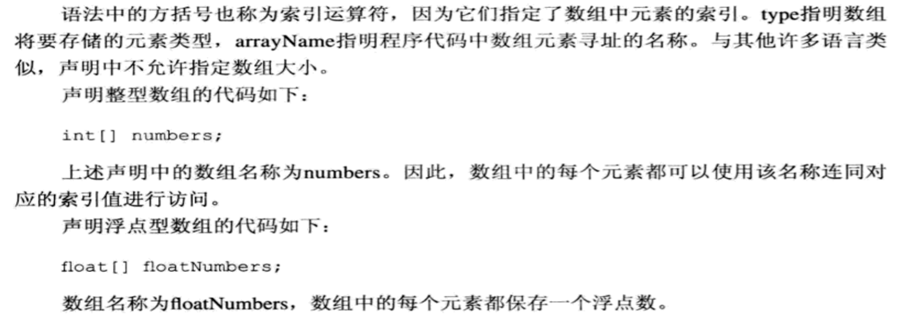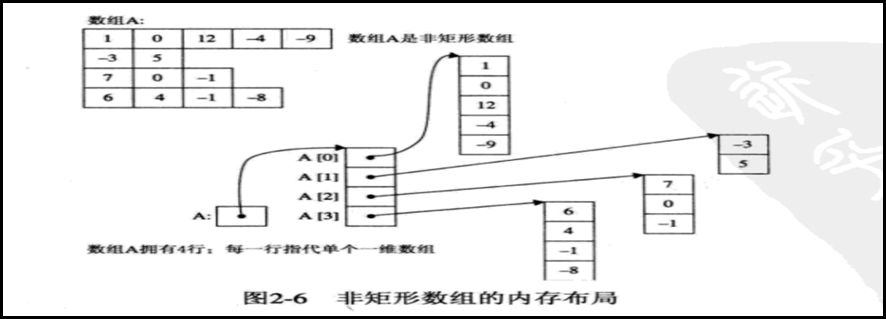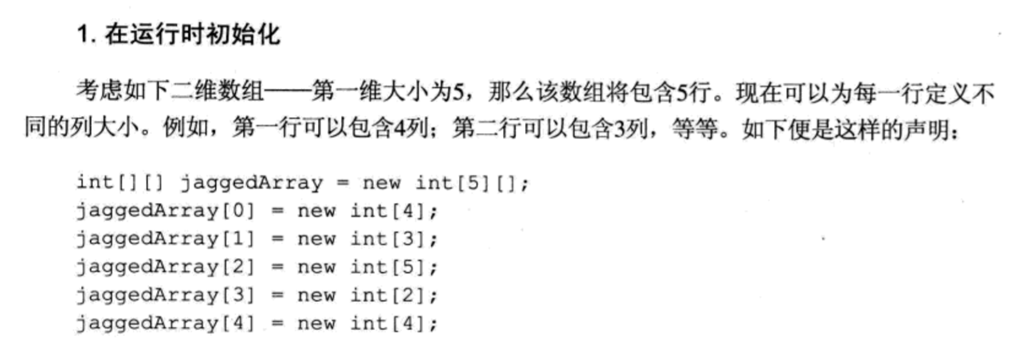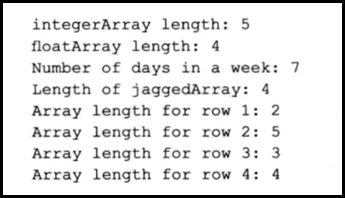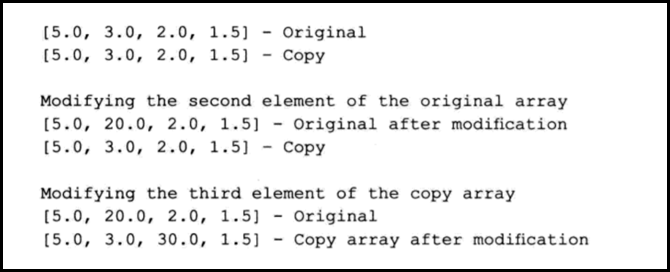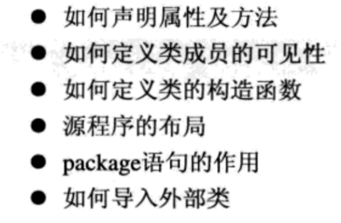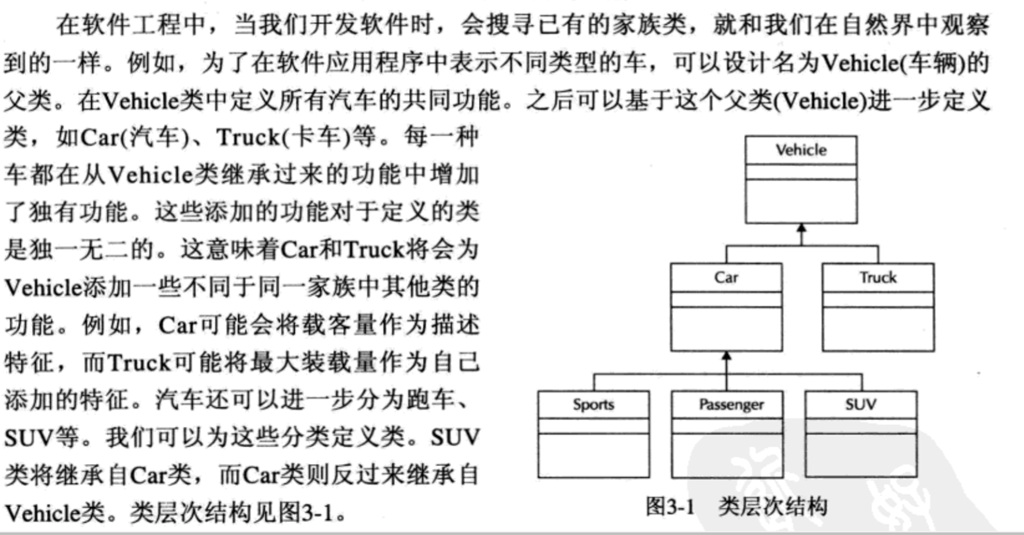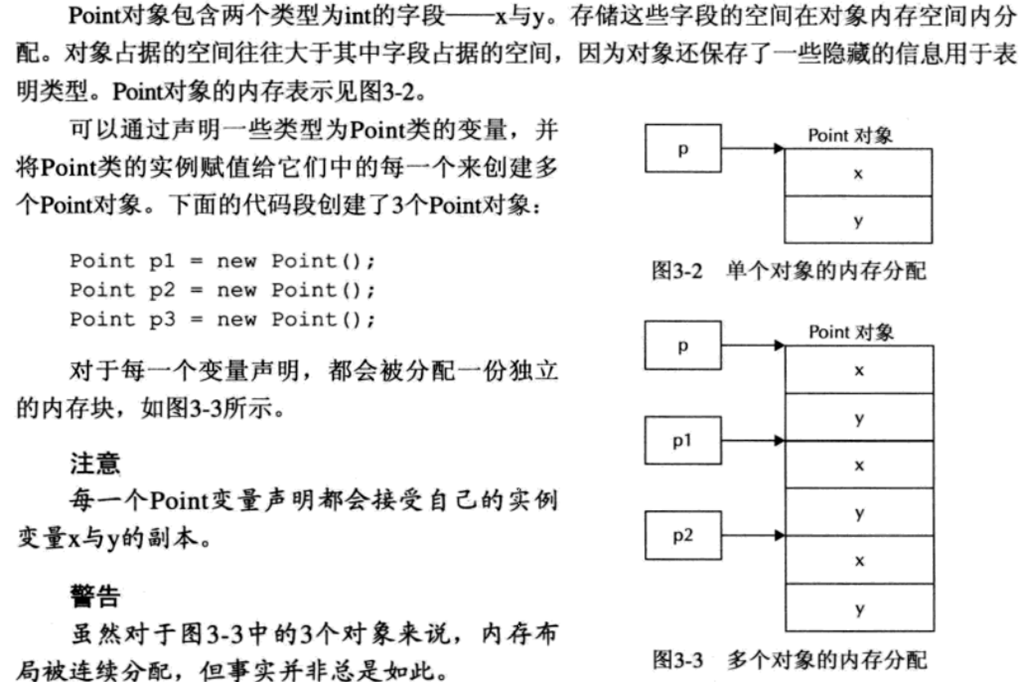本书PDF 下载地址: http://pan.baidu.com/s/1c141KGS 密码:v6i1
注:本文有空会跟新;
讲述的是jdk7的内容;
注关于java 更详细的内容请进入:《Java 8编程官方参考教程(第9版).pdf》学习笔记 进行学习
第1章Java简介
1:为什么使用Java
1:java 诞生时C++太费电脑资源,不方便嵌入式移植
2:java 编写一次到处运行
2:什么是Java
java 是一门编程语言,移除了内存管理、安全性这类复杂的特性,转而将这些任务交给了虚拟机管理。
3:Java虚拟机
java编译器将java源程序编译成二进制“伪CPU指令构成”的字节码。Java虚拟机仿真了虚拟CPU,为java可执行文件提供了运行环境、字节码解释器、验证器。其中验证器用于内存
管理、线程管理等其他用途。JVM本质是能够运行Java可执行文件的机器。java编译文件以“.class”形式结尾。
4:Java特性
1:体积小
2:简单易学
3:面向对象
4:兼具编译与解释特性
5:与运行平台无关
6:执行安全
7:支出多线程
8:动态特性:内省(introspection) 反射(reflection)
5:ava的演变过程
1: 1996年1月23日):代号Oak
1: 提供了类库
2:提供applet互联网小程序
2:JDK1.1(1997年2月19日)
1:引入javaBean 组件。
2:引入 远程方法调用。让客户端调用运行在远程服务器的应用程序
3:jar文件格式
4:数字签名
5:AWT增强
6:其他改动
3:JDK1.2(1998年12月8日):代号Playground
1:引入Swing 图形编辑类库
2:提供 2D API
3: 实现拖拽功能
4:音频增强
5:引入 java平台上的ORB 对象请求代理实现类库
6:安全增强
7:其他增强
4:JDK1.3(2000年5月8日):代号Kestrel
5:JDK1.4(2002年2月6日):代号Merlin
6:JDK5.0(2004年9月30日):代号Tiger
7: JDKSE6(2006年12月11日):代号Mustang
8:JDKSE7(2011年7月7日):代号Dolphin
第2章:数组
、
1:数组介绍
1:作用:用来处理相同数据类型的变量集合
2:本质:相同数据类型的元素的集合,其中元算是数组的组成部分。数组中的每个元算可以使用唯一的
索引值(下标)
进行访问。
2:数组声明
1: 声明语法:
1 type arrayName();
或者是:
1 type[ ] arrayName ;
3:创建数组
1:示例:
1 int [ ] numberArray; //声明一个数组类型变量 numberArray ,其数组元素类型为int 2 numberArray= new int[20] ; //保存10个整数分配了连续内存,并将首个元算内存地址赋值给变量numberArray.数组初始化器为numberArray数组所有元算提供初始化值。
4:访问和修改数组元算
1 //访问数组元素:就是使用索引来访问数组元算。数组的每个元算都拥有唯一的索引值。数组元素可以使用数组名并跟上方括号内的索引值进行访问。 2 3 arrayName[indexValue]; 4 5 //示例: 6 int[] num=new int[5]; 7 int a1=num[0];//注意:下标是从0开始算数组总长度个数值的;如果下标不对则会出现 ArrayIndexOutOfBounds异常。
5:初始化数组
1:运行时初始化
1 //示例: 2 int[] num_Array=net int[10]; 3 //赋值 4 num_Array[0]=0; 5 num_Array[1]=1; 6 num_Array[2]=2; 7 ... 8 num_Array[10]=10; 9 //如果值相同或则有规律可循。往往使用循环比较好用 10 for(int 1=0;i<10;i++){ 11 num_Array[i]=i+1; 12 }
2: 使用数字字面量初始化
1 int[] num_Array={1,2,3,4,5,6,7,78} ;
1 2 import java.io.*; 3 /** 4 * 显示数组用法程序 5 * 6 **/ 7 public class TestScoreAverage { 8 9 public static void main(String[] args) { 10 final int NUMBER_OF_STUDENTS = 5;//final 关键字在程序中创建常量,变量被声明后值不可以再此被改变
11 int[] marks = new int[NUMBER_OF_STUDENTS]; 12 try { 13 BufferedReader reader = new BufferedReader(new InputStreamReader( System.in)); 15 for (int i = 0; i < NUMBER_OF_STUDENTS; i++) { 16 System.out.print("Enter marks for student #" + (i + 1) + ": "); 17 String str = reader.readLine(); 18 marks[i] = Integer.parseInt(str); 19 } 20 } catch (Exception e) { 21 e.printStackTrace(); 22 } 23 int total = 0; 24 for (int i = 0; i < NUMBER_OF_STUDENTS; i++) { 25 total += marks[i]; 26 } 27 System.out.println("Average Marks " + (float) total 28 / NUMBER_OF_STUDENTS); 29 } 30 }
6:for_each 遍历循环数组 取值
1 //for_each循环可以在不使用元素索引值的情况下遍历整个数组 2 3 //这个是jdk5的新特性 4 for(type varableName :collection){ 5 loopBody 6 } 7
具体示例如下:
1 int[] n ={1,2,3,4,5,6,7,7,7,67,6}; 2 for(int m: n){ 3 System.out.println(m); 4 } 5
7: 多维数组
即:指包含数组维数多于1维;可以创建二维、三维和n维数组(1<=n<=255)。
1:二维数组声明和初始化
1 2 //---------------------------------------------------------------------------------------- 3 //二维数组:例如一个包含 行与列的表格。其中表格的每一个单元格代表一个数组元算。 4 //声明格式如下: 5 type arrayName[][]; 6 type[] [] arrayname; 7 8 //具体示例如下: 9 final int n1=5; // 代表行 10 final int n2=10 ; //代表列 11 12 int[ ] [ ] m ; 13 m=new int[n1] [n2] ; 14 15 //其元素格值显示: 16 m[4][5]=5; 17 18 //-------初始化------------------------------------------------------------------------ 19 //1:运行时初始化 20 arrayName[row] [col] =data; 21 //例如: 22 int [][] m =new int[5][10];' 23 //数组的单元格可以使用如下程序初始化 24 m[0][1]=1; 25 m[0][2]=2; 26 .... 27 m[5][10]=50 28 29 30 //2:循环初始化 31 32 final int r=5;c=10 ; 33 int [][] m=new int[r][c]; 34 for(int i=o;i<r;i++){ 35 for(int j=0;j<c;j++){ 36 m[r][n]=i*j; 37 } 38 } 39 40 //使用数组字面量初始化 41 int [][] m={{1,1},{2,2},{3,3},{4,5}};
1 2 3 /** 4 * 展示使用二维数组的程序 5 * 6 **/ 7 public class MultiDimArrayApp { 8 9 public static void main(String[] args) { 10 final int MAX_STUDENTS = 50, MAX_SUBJECTS = 3; 11 int[][] marks = new int[MAX_STUDENTS][MAX_SUBJECTS]; 12 // Adding data to the array 13 for (int id = 0; id < MAX_STUDENTS; id++) { 14 for (int subject = 0; subject < MAX_SUBJECTS; subject++) { 15 marks[id][subject] = (int) (Math.random() * 100); 16 } 17 } 18 // Printing Array 19 System.out.print("Student "); 20 for (int subject = 0; subject < MAX_SUBJECTS; subject++) { 21 System.out.print(" " + "Subject " + subject + " "); 22 } 23 System.out.println(); 24 for (int id = 0; id < MAX_STUDENTS; id++) { 25 System.out.print("Student " + (id + 1) + ' '); 26 for (int subject = 0; subject < MAX_SUBJECTS; subject++) { 27 System.out.print(" " + marks[id][subject] + " "); 28 } 29 System.out.println(); 30 } 31 } 32 }
2: 使用 for_each循环
1 int i=0; 2 for(int[] a:m){ 3 System.out.println("a"+i+++' '); 4 for(int v : a){ 5 System.out.println(" "+v+" "); 6 } 7 System.out.println(); 8 }
8:N维数组
1 //三维数组声明 2 type[][][] arrayName=new type[size][size][ size ] ; 3 //即: 4 int [][][]a=new int[1][2][3];
9:非矩形数组
10:确定长度
1 /** 2 * 确定数组长度 3 * 4 **/ 5 public class ArrayLengthApp { 6 7 public static void main(String[] args) { 8 final int SIZE = 5; 9 int[] integerArray = new int[SIZE]; 10 float[] floatArray = {5.0f, 3.0f, 2.0f, 1.5f}; 11 String[] weekDays = {"Sunday", "Monday", "Tuesday", 12 "Wednesday", "Thursday", "Friday", "Saturday"}; 13 int[][] jaggedArray = { 14 {5, 4}, 15 {10, 15, 12, 15, 18}, 16 {6, 9, 10}, 17 {12, 5, 8, 11} 18 }; 19 System.out.println("integerArray length: " + integerArray.length); 20 System.out.println("floatArray length: " + floatArray.length); 21 System.out.println("Number of days in a week: " + weekDays.length); 22 System.out.println("Length of jaggedArray: " + jaggedArray.length); 23 int row = 0; 24 for (int[] memberRow : jaggedArray) { 25 System.out.println(" Array length for row " 26 + ++row + ": " + memberRow.length); 27 } 28 } 29 }
结果输出:
11: 数组复制
1 2 import java.util.Arrays; 3 /** 4 * 数组复制 5 * 6 **/ 7 public class ArrayCopyApp { 8 9 public static void main(String[] args) { 10 float[] floatArray = {5.0f, 3.0f, 2.0f, 1.5f}; 11 float[] floatArrayCopy =floatArray.clone(); //此方法为数组的复制方法:把a数组的所有元算复制到b数组中
12 System.out.println(Arrays.toString(floatArray) + " - Original"); 13 System.out.println(Arrays.toString(floatArrayCopy) + " - Copy"); 14 System.out.println(); 15 System.out.println("Modifying the second element of the original array"); 16 floatArray[1] = 20; 17 System.out.println(Arrays.toString(floatArray) 18 + " - Original after modification"); 19 System.out.println(Arrays.toString(floatArrayCopy) + " - Copy"); 20 System.out.println(); 21 System.out.println("Modifying the third element of the copy array"); 22 floatArrayCopy[2] = 30; 23 System.out.println(Arrays.toString(floatArray) + " - Original"); 24 System.out.println(Arrays.toString(floatArrayCopy) 25 + " - Copy array after modification"); 26 } 27 }
执行后输出结果如下:
12:找出数组的类表示
1 /** 2 * 找出数组的类表示 3 * 4 **/ 5 public class ArrayClassNameApp { 6 7 public static void main(String[] args) { 8 final int SIZE = 5; 9 int[] integerArray = new int[SIZE]; 10 float[] floatArray = {5.0f, 3.0f, 2.0f, 1.5f}; 11 String[] weekDays = {"Sunday", "Monday", "Tuesday", 12 "Wednesday", "Thursday", "Friday", "Saturday"}; 13 int[][] jaggedArray = { 14 {5, 4}, 15 {10, 15, 12, 15, 18}, 16 {6, 9, 10}, 17 {12, 5, 8, 11} 18 }; 19 Class cls = integerArray.getClass(); 20 21 System.out.println( 22 "The class name of integerArray: " +cls.getName()
);// arrayName.getClass()
23 cls = floatArray.getClass(); 24 25 System.out.println( 26 "The class name of floatArray: " + cls.getName()); 27 cls = weekDays.getClass(); 28 29 System.out.println( 30 "The class name of weekDays: " + cls.getName()); 31 cls = jaggedArray.getClass(); 32 33 System.out.println( 34 "The class name of jaggedArray: " + cls.getName()); 35 System.out.println(); 36 cls = cls.getSuperclass(); 37 38 System.out.println( 39 "The super class of an array object: " 40 + cls.getName()); 41 } 42 }
第三章:类
1:面向对象概念
1:面向对象编程的特性
1:封装
2:继承
3:动态
2:面向对象编程的好处
2:类
1: 定义类
1 //定义类的一般形式如下: 2 Modifiers可选
class ClassName{ 3 classBody可选
4 }
1 ClassModifieres
可选
class Identifier ClassBody
1 //class 关键字之前的修饰符用于定义类的可见性 2 3 class MyClass{ 4 //attributes 5 // constructors 6 //methods 7 8 }
2: 定义Point 类
1 /* 2 *声明Point类 3 */ 4 5 class Point{ 6 int x; 7 int y; 8 9 } 10 11 /* 说明: 12 * 该类使用关键字class 并紧跟类名Point 定义而成。由于修饰符在类定义时是可以选的,因此并未 13 * 包含在上述的定义中。修饰符用于定义类的可见性。 14 * {} 中的内容表示类的主体。 15 */
3:使用类
1 Point p=new Point();
4: 访问/修改字段
5: 类的示例程序
1 2 class Point { 3 4 int x; 5 int y; 6 } 7 8 class TestPoint { 9 10 public static void main(String[] args) { 11 System.out.println("Creating a Point object ... "); 12 Point p = new Point(); 13 System.out.println("Initializing data members ..."); 14 p.x = 4; 15 p.y = 5; 16 System.out.println("Printing object"); 17 System.out.println("Point p (" + p.x + ", " + p.y + ")"); 18 } 19 }
6:方法声明
1 2 import java.util.*; 3 4 class Point { 5 6 int x; 7 int y; 89 double getDistance() { 10 return (Math.sqrt(x * x + y * y)); 11 }
12 } 13 14 class TestPoint { 15 16 public static void main(String[] args) { 17 System.out.println("Creating a Point object ... "); 18 Point p1 = new Point(); 19 System.out.println("Initializing object ..."); 20 p1.x = 3; 21 p1.y = 4; 22 double distance = p1.getDistance(); 23 StringBuilder sb = new StringBuilder(); 24 Formatter formatter = new Formatter(sb, Locale.US); 25 formatter.format("Distance of Point p1(" + p1.x + "," + p1.y 26 + ") from origin is %.02f", distance); 27 System.out.println(sb); 28 System.out.println(); 29 sb.delete(0, sb.length()); 30 System.out.println("Creating another Point object ... "); 31 Point p2 = new Point(); 32 System.out.println("Initializing object ..."); 33 p2.x = 8; 34 p2.y = 9; 35 distance = p2.getDistance(); 36 formatter.format("Distance of Point p2(" + p2.x + "," 37 + p2.y + ") from origin is %.02f", distance); 38 System.out.println(sb); 39 } 40 }
当编译运行时结果如下:
7:对象内存表示
3:信息掩藏
1:展示信息掩藏概念的程序
1 2 class Wallet { 3 4 private float money; 5 6 public void setMoney(float money) { 7 this.money = money; 8 } 9 10 public boolean pullOutMoney(float amount) { 11if (money >= amount) { 12 money -= amount; 13 return true; 14 } 15 return false;
16 } 17 } 18 19 class Person { 20 21 public static void main(String[] args) { 22 Wallet wallet = new Wallet(); 23 System.out.println("Putting $500 in the wallet "); 24 wallet.setMoney(500); 25 System.out.println("Pulling out $100 ..."); 26 boolean isMoneyInWallet = wallet.pullOutMoney(100); 27 if (isMoneyInWallet) { 28 System.out.println("Got it!"); 29 } else { 30 System.out.println("Nope, not enough money"); 31 } 32 System.out.println(" Pulling out $300 ..."); 33 isMoneyInWallet = wallet.pullOutMoney(300); 34 if (isMoneyInWallet) { 35 System.out.println("Got it!"); 36 } else { 37 System.out.println("Nope, not enough money"); 38 } 39 System.out.println(" Pulling out $200 ..."); 40 isMoneyInWallet = wallet.pullOutMoney(200); 41 if (isMoneyInWallet) { 42 System.out.println("Got it!"); 43 } else { 44 System.out.println("Nope, not enough money"); 45 } 46 } 47 }
编译运行结果如下:
4:封装
1 class Date{ 2 3 4 public int day; 5 public int mount; 6 public int year; 7 8 public void setMount(int month){ 9 if(month >=1&& month <=12){ 10 this.month=month; 11 }else{ 12 System.out.println(month); 13 } 14 15 } 16 17 }



